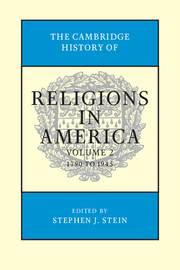Book contents
- Frontmatter
- Contents
- Contributors
- Editor's Introduction
- SECTION I RELIGION IN NORTH AMERICA
- SECTION II RELIGIONS IN THE NEW NATION, 1790–1865
- SECTION III CHANGING RELIGIOUS REALITIES
- SECTION IV RELIGIOUS RESPONSES TO MODERN LIFE AND THOUGHT
- SECTION V COMPARATIVE ESSAYS
- 31 Religion in Canada, 1867–1945
- 32 Religious Developments in Mexico, 1865–1945
- 33 Caribbean Religious History, 1865–1945
- SECTION VI RELIGION AND DIVERSE AREAS
- Index
- References
31 - Religion in Canada, 1867–1945
from SECTION V - COMPARATIVE ESSAYS
Published online by Cambridge University Press: 28 July 2012
- Frontmatter
- Contents
- Contributors
- Editor's Introduction
- SECTION I RELIGION IN NORTH AMERICA
- SECTION II RELIGIONS IN THE NEW NATION, 1790–1865
- SECTION III CHANGING RELIGIOUS REALITIES
- SECTION IV RELIGIOUS RESPONSES TO MODERN LIFE AND THOUGHT
- SECTION V COMPARATIVE ESSAYS
- 31 Religion in Canada, 1867–1945
- 32 Religious Developments in Mexico, 1865–1945
- 33 Caribbean Religious History, 1865–1945
- SECTION VI RELIGION AND DIVERSE AREAS
- Index
- References
Summary
When the final draft of the British North America Act was being completed at the London conference in December 1866, one of the thorniest problems facing the delegates was a name for the new nation. While reading the Bible, as was his custom every evening, Samuel Tilley of New Brunswick stumbled upon a phrase from Psalm 72, “His Dominion shall also be from sea to sea.” The suggestion of “the Dominion of Canada” was seized upon by the Fathers of Confederation as an appropriate choice. Although the churches in Canada did not play a significant role in confederation, this phrase inspired a sense of mission to build a Christian nation from sea to sea. The biblical reference also resonated with the overwhelmingly Christian character of the new country. Over 98 percent of the people indicated to Canada's first census takers in 1871 that they were Christian. Of the population, 43 percent was Roman Catholic, while another 52 percent was from one of four mainstream denominations – Anglican, Methodist, Presbyterian, or Baptist. Most of the remaining population was either Lutheran or members of a pacifist group, such as Quakers or Mennonites. The non-Christian population was very small, with only eleven hundred Jews, and most of them concentrated in the city of Montreal.
- Type
- Chapter
- Information
- The Cambridge History of Religions in America , pp. 675 - 701Publisher: Cambridge University PressPrint publication year: 2000

